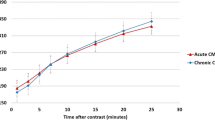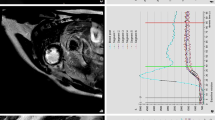Abstract
In patients with myocardial infarction infarct size and transmural extent are of high prognostic value for clinical outcome and recovery of contractile function of the affected myocardium either spontaneously or after revascularisation. Delayed contrast-enhancement magnetic resonance imaging (DCE-MRI) is a non-invasive imaging technique of high accuracy for determination of myocardial infarct size and transmural extent. As decisions whether revascularisation procedures are promising in patients with coronary artery disease are increasingly based on the transmural infarct extent assessed by DCE-MRI we sought to examine whether the timing of MRI after acute myocardial infarction would influence the transmural extent. We performed DCE-imaging on a clinical 1.5 T scanner in patients at day-1 and day-7 after reperfused STEMI. We assessed the total number of segments displaying DCE as well as differentiated by the transmural infarct extent. The total number of affected segments as well as the number of segments with only subendocardial DCE did not change between day-1 and day-7. In contrast, we observed a significant decrease of the number of segments with DCE of ≥75% transmurality and a significant increase of segments with DCE grade III (51%–75% transmurality). We conclude that the transmural infarct extent is not stable over the first days after STEMI which should be taken into account when assessing viability in clinical and research settings.

Similar content being viewed by others
References
Baks T, van Geuns RJ, Biagini E, Wielopolski P, Mollet NR, Cademartiri F, Boersma E, van der Giessen WJ, Krestin GP, Duncker DJ, Serruys PW, de Feyter PJ (2006) Effects of primary angioplasty for acute myocardial infarction on early and late infarct size and left ventricular wall characteristics. J Am Coll Cardiol 47:40–44
Barclay JL, Egred M, Kruszewski K, Nandakumar R, Norton MY, Stirrat C, Redpath TW, Walton S, Hillis GS (2006) The relationship between transmural extent of infarction on contrast enhanced magnetic resonance imaging and recovery of contractile function in patients with first myocardial infarction treated with thrombolysis. Cardiology 108:217–222
Cerqueira MD, Weissman NJ, Dilsizian V, Jacobs AK, Kaul S, Laskey WK, Pennell DJ, Rumberger JA, Ryan T, Verani MS (2002) Standardized myocardial segmentation and nomenclature for tomographic imaging of the heart. Circulation 105:539–542
Choi KM, Kim RJ, Gubernikoff G, Vargas JD, Parker M, Judd RM (2001) Transmural extent of acute myocardial infarction predicts long-term improvement in contractile function. Circulation 104:1101–1107.
Fieno DS, Hillenbrand HB, Rehwald WG, Harris KR, Decker RS, Parker MA, Klocke FJ, Kim RJ, Judd RM (2004) Infarct resorption, compensatory hypertrophy, and differing patterns of ventricular remodelling following myocardial infarctions of varying size. J Am Coll Cardiol 43:2124–2131
Judd RM, Lugo-Olivieri CH, Arai M, Kondo T, Croisille P, Lima JAC, Mohan V, Becker LC, Zerhouni EA (1995) Physiological basis of myocardial contrast enhancement in fast magnetic resonance images of 2-day-old reperfused canine infarcts. Circulation 92:1902–1910
Kim RJ, Wu E, Rafael A, Chen EL, Parker MA, Simonetti O, Klocke FJ, Bonow RO, Judd RM (2000) The use of contrast-enhanced magnetic resonance imaging to identify reversible myocardial dysfunction. NEJM 343:1445–1453
Kloner RA (1993) Does reperfusion injury exist in humans? J Am Coll Cardiol 21:537–545
Schuijf JD, Kaandorp TA, Lamb HJ, van der Geest RJ, Viergever EP, van der Wall EE, de Roos A, Bax JJ (2004) Quantification of myocardial infarct size and transmurality by contrast-enhanced magnetic resonance imaging in men. Am J Cardiol 94:284–288
Steen H, Lehrke S, Wiegand U, Merten C, Schuster L, Richardt G, Kulke C, Gehl HB, Lima JAC, Katus HA, Giannitsis E (2005) Very early cardiac magnetic resonance imaging for quantification of myocardial tissue perfusion in patients receiving tirofiban before percutaneous coronary intervention for ST-elevation myocardial infarction. Am Heart J 149:564.e1–564.e7
Turschner O, D’hooge J, Dommke C, Claus P, Verbeken E, De Scheerder I, Bijnens B, Sutherland RS (2004) The sequential changes in myocardial thickness and thickening which occur during acute transmural infarction, infarct resorption and the resultant expression of reperfusion injury. Eur Heart J 25:794–803
Author information
Authors and Affiliations
Corresponding author
Additional information
C. Merten and H. Steen contributed equally
Rights and permissions
About this article
Cite this article
Merten, C., Steen, H., Kulke, C. et al. Contrast-enhanced magnetic resonance imaging reveals early decrease of transmural extent of reperfused acute myocardial infarction. Clin Res Cardiol 97, 913–916 (2008). https://doi.org/10.1007/s00392-008-0710-5
Received:
Accepted:
Published:
Issue Date:
DOI: https://doi.org/10.1007/s00392-008-0710-5




